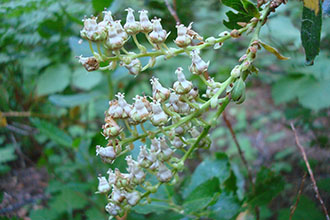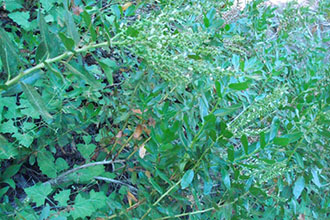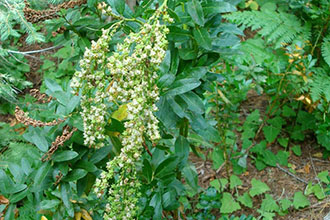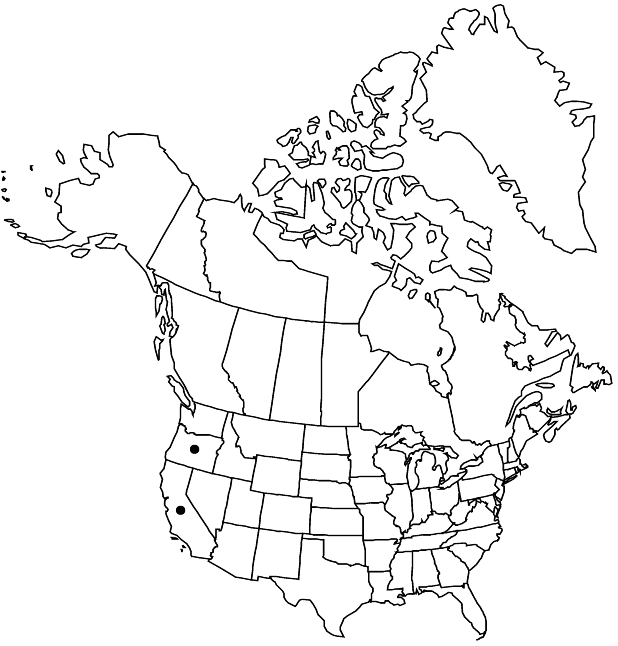Taxonomy: Kingdom - Plantae (plants). Subkingdom - Tracheobionta (vascular plants). Superdivision - Spermatophyta (seed plants). Division - Magnoliophyta (flowering plants). Class - Magnoliopsida (dicotyledons). Subclass - Dilleniidae. Order - Ericales. Family - Ericaceae (heath). Genus - Leucothoe D. Don. Species -Leucothoe davisiae Torr. ex A. Gray
Leucothoe davisiae
Sierra laurel
Ericaceae
 |
 |
 |
The Basics
Identification
Plants 0.3-1.5 m, branches erect, 0.3-1.5 m. Leaves: petiole 3-6 mm; blade oblong to elliptic, 1-6 cm, margins sparsely toothed, apex shortly acute to obtuse, surfaces glabrous. Inflorescences fascicled, sessile, dense, 20-60-flowered, 5-15 cm; bracts deciduous, ovate, 1.7-2 mm. Pedicels 2-3 mm. Flowers: sepals whitish, lanceolate-ovate, 2.5-3.3 mm, apex acute or subacute; corolla urceolate, 6-8 mm; filaments glabrous; anthers 1.2-1.4 mm, with 2 awns (sometimes awns absent); ovary glabrous. Capsules 4.5-6 mm wide. Seeds ellipsoid or oblong; testa firm, reticulate. Flowering mid spring.
Threats
Leucothoe davisiae is posionius to humans and live stock. Due to it containing diterpenoid compounds grayanotoxins or andromedotoxins. This can effect sheep in as little as 25 gram of leaves. This plant is often eaten by livestock creating it a hazard for grazing species. This species is also affected by fire. In the YFDP: Sierra laurel mainly grows in riparian areas, which served as fire refugia during the 2013 fire. Otherwise, sierra laurel was top-killed by fire.
Reproduction
Inflorescence - raceme, in fall, bracted; pedicel jointed to flower, bractlets 2, +/- basal. In upper leaf axils, < 15 cm, many-flowered; pedicel recurved. Flower - sepals 5, fused at base; petals 5, fused, [cylindric to] urn-shaped; stamens 10, anthers dehiscing by pores, awns 4, [elongate to] vestigial, filaments +/- straight, with hairs, papillae [or only papillae]; ovary superior, chambers 5, placentas axile, stigma truncate [or head-like/peltate]. Fruit - capsule, loculicidal, erect, persistent after seed dispersal, dehiscing tip to base. Corolla 5.5-8.5 mm, calyx, white. Seed - many per chamber, small, generally winged. < 6 mm wide, thin-walled.
Species Distribution
 |
Citation
USDA Plants Database
USDA, NRCS. 2016. The PLANTS Database. National Plant Data Team, Greensboro, NC 27401-4901 USA.
Flora of North America
Flora of North America Editorial Committee, eds. 1993+. Flora of North America North of Mexico. 19+ vols. New York and Oxford.
SEINET
Tucker, G. C. (n.d.). SEINET Arizona - New Mexico Chapter. Retrieved from Leucothoe davisiae: www.swbiodiversity.org/seinet/taxa/index/php?taxon=89242&clid=4309
The Jepson Herbarium
The Jepson Manual: Vascular Plants of California. B.G. Baldwin, D.H. Goldman, D.J. Keil, R. Patterson, T.J. Rosatti, and D.H. Wilken [editors]. 2012. 2nd edition, thoroughly revised and expanded. University of California Press, Berkeley, CA.